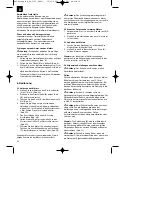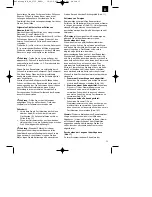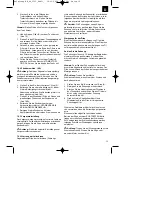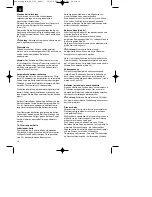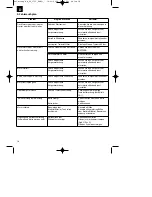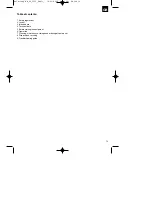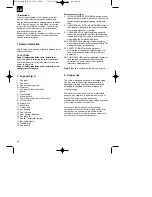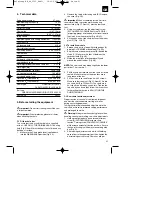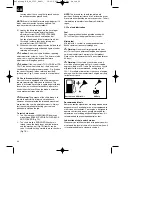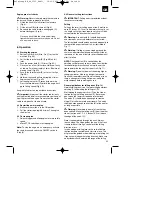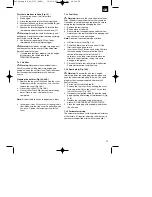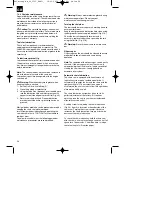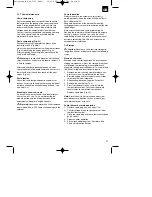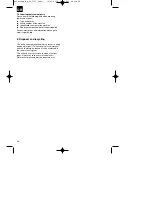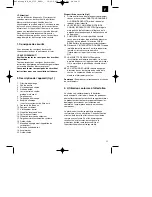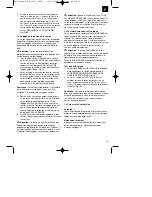
Engine pre-start checks
Warning:
Never start or operate the saw unless
the bar and chain are properly installed.
1.
Fill the fuel tank (A) with correct fuel mixture
(Fig. 8).
2.
Fill the oil tank (B) with chain oil (Fig. 8).
3.
Be certain the chain brake is disengaged (C)
before starting unit (Fig. 8).
Once you have filled the chain and oil tank,
tighten the tank cover securely by hand. Do not
use any tools to do so.
6. Operation
6.1 Starting the engine
1.
Set the On/Off switch (A) to “On (I)” to start the
machine (Fig. 9A).
2.
Pull out the throttle lever (B) (Fig. 9B) until it
locks.
3.
Push the primer bulb (C) 10 times (Fig. 9C).
4.
Place saw on a firm, flat surface. Hold saw firmly
as shown. Pull starter rapidly 2 times. Beware of
moving chain! (Fig.9D)
5.
Push in the throttle lever (B) as far as it will go
(Fig. 9B).
6.
Hold saw firmly and pull starter rapidly 4 times.
Engine should start (Fig. 9D).
7.
Let the engine run for 10 seconds to warm up.
Press the throttle lever (D) briefly, the engine will
go to “idling” speed (Fig. 9E).
If engine failed to start, repeat these instructions.
Important:
Always pull the starter cable slowly
until you feel the initial resistance before you then pull
it quickly to start the engine. Do not allow the starter
cable to whip back of its own accord.
6.2 Restarting a warm engine
1.
Make sure the switch is in the ON position.
2.
Pull the starter rope rapidly 6 times. The engine
should start.
6.3 To stop engine
1.
Release trigger and allow engine to return to idle
speed.
2.
Move STOP switch down to stop engine.
Note:
To stop the engine in an emergency, activate
the chain brake and switch the ON/OFF switch to
“Stop (0)”.
6.4 General cutting instructions
IMPORTANT:
Felling trees is prohibited without
the necessary training!
Felling
Felling is the term for cutting down a tree. Small trees
up to 6-7 inches (15-18cm) in diameter are usually cut
in a single cut. Larger trees require notch cuts. Notch
cuts determine the direction the tree will fall.
Warning:
A retreat path (A) should be planned
and cleared as necessary before cuts are started.
The retreat path should extend back and diagonally to
the rear of the expected line of fall, as illustrated in
Fig. 11.
Warning:
If felling a tree on sloping ground, the
chain saw operator should keep on the uphill side of
the terrain, as the tree is likely to roll or slide downhill
after it is felled.
NOTE:
Direction of fall (B) is controlled by the
notching cut. Before any cuts are made, consider the
location of larger branches and natural lean of the
tree to determine the way the tree will fall (Fig. 11).
Warning:
Do not cut down a tree during high or
changing winds or if there is a danger to property.
Consult a tree professional. Do not cut down a tree if
there is a danger of striking utility wires; notify the
utility company before making any cuts.
General guidelines for felling trees (Fig. 12)
Normally felling consists of 2 main cutting operations,
notching (C) and making the felling cut (D).
Start making the upper notch cut (C) on the side of
the tree facing the felling direction (E). Be sure you
don t make the lower cut too deep into the trunk.
The notch (C) should be deep enough to create a
hinge (F) of sufficient width and strength. The notch
should be wide enough to direct the fall of the tree for
as long as possible.
Warning:
Never walk in front of a tree that has
been notched. Make the felling cut (D) from the other
side of the tree and 1.5 - 2.0 inches (3-5 cm) above
the edge of the notch (C).
Never saw completely through the trunk. Always
leave a hinge. The hinge guides the tree. If the trunk
is completely cut through, control over the felling
direction is lost.
Insert a wedge or felling lever in the cut well before
the tree becomes unstable and starts to move. This
will prevent the guidebar from binding in the felling cut
if you have misjudged the falling direction. Make sure
no bystanders have entered the range of the falling
23
GB
Anleitung BG_PC_3735_SPK1:_ 16.03.2009 8:12 Uhr Seite 23




